Brain Enhancing Ingredients from Āyurvedic Medicine: Quintessential Example of Bacopa monniera, a Narrative Review
Abstract
:1. Introduction
1.1. What Is Āyurveda?
1.2. Mental Ill-Health

2. Āyurvedic Concept of Life Span, Health and Brain Aging
2.1. Life Span
2.2. Health
2.3. Brain Aging
| Decade of Life | Desired Effect/ Loss of Physiological Attributes | Rasayana Plants |
|---|---|---|
| 1–10 | Formation, development and promotion of speech childhood/boyishness | Vāca (Acorus calamus; family: Acoraceae). |
| 11–20 | Growth; attaining puberty and a healthy growth of brain and body. | Brahmi (Bacopa monniera; family: Scrophulariaceae); Bala (Sida cordifolia; family: Malvaceae); and Kasmari (Abutilon indicum; family: Malvaceae). |
| 21–30 | Promotion of intellect/luster/complexion | Brahmi (Bacopa monniera; family: Scrophulariacae) and Amalaki (Emblica officinalis; family: Euphorbiaceae). |
| 31–40 | Cognitive functions and memory | Brahmi (Bacopa monniera; family: Scrophulariacae) and Shankhpushpi (Evolvulus alsinoides; family: Convolvulaceae. |
| 41–50 | Skin | Brahmi (Bacopa monniera; family: Scrophulariacae) and Jyotishmati (Celastrus peniculatis; family: Celastraceae). |
| 51–60 | Vision | Brahmi (Bacopa monniera; family: Scrophulariacae) and Jyotishmati (Celastrus peniculatis; family: Celastraceae). |
| 61–70 | Virility and procreative prowess | Ashwagandha (Withania somnifera; family: Solanaceae) and Brahmi (Bacopa monniera; family: Scophulariacae). |
| 71–80 | Physical strength, sensorial and muscular coordination | Amalaki (Emblica officinalis; family: Euphorbiacae) and Brahmi (Bacopa monniera; family: Scrophulariacae). |
| 81–90 | Discriminative faculty, intelligence and decision making capacity | Brahmi (Bacopa monniera; family: Scrophulariacae). |
| 91–100 | Mental coordination, locomotor action and mobility | Brahmi (Bacopa monniera; family: Scrophulariacae). |
3. Diet and Nutrition
3.1. Diet and Health in Carak-Samhitā
3.2. Diet and Health in Suśrūta-Samhitā
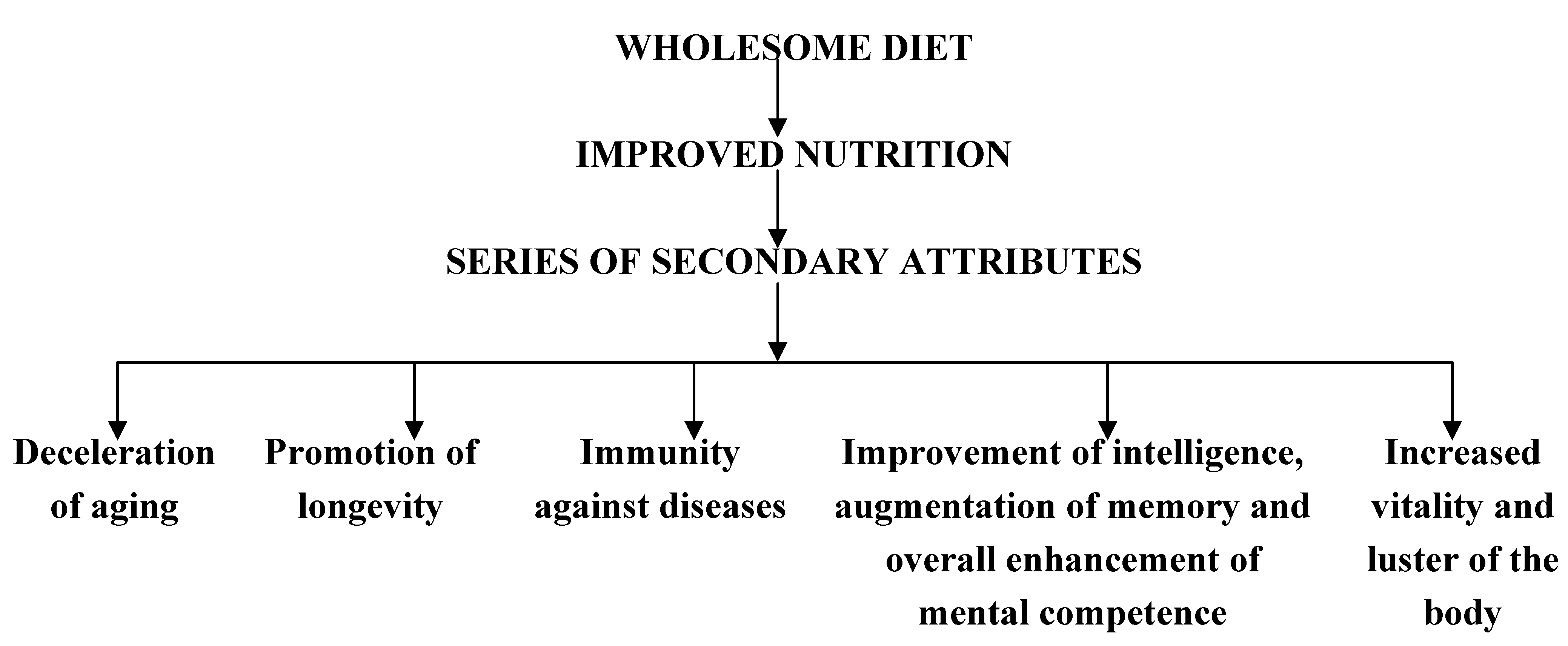
3.3. Bhūtvidyā (Psychology, including Clinical Psychology and Psychiatry)

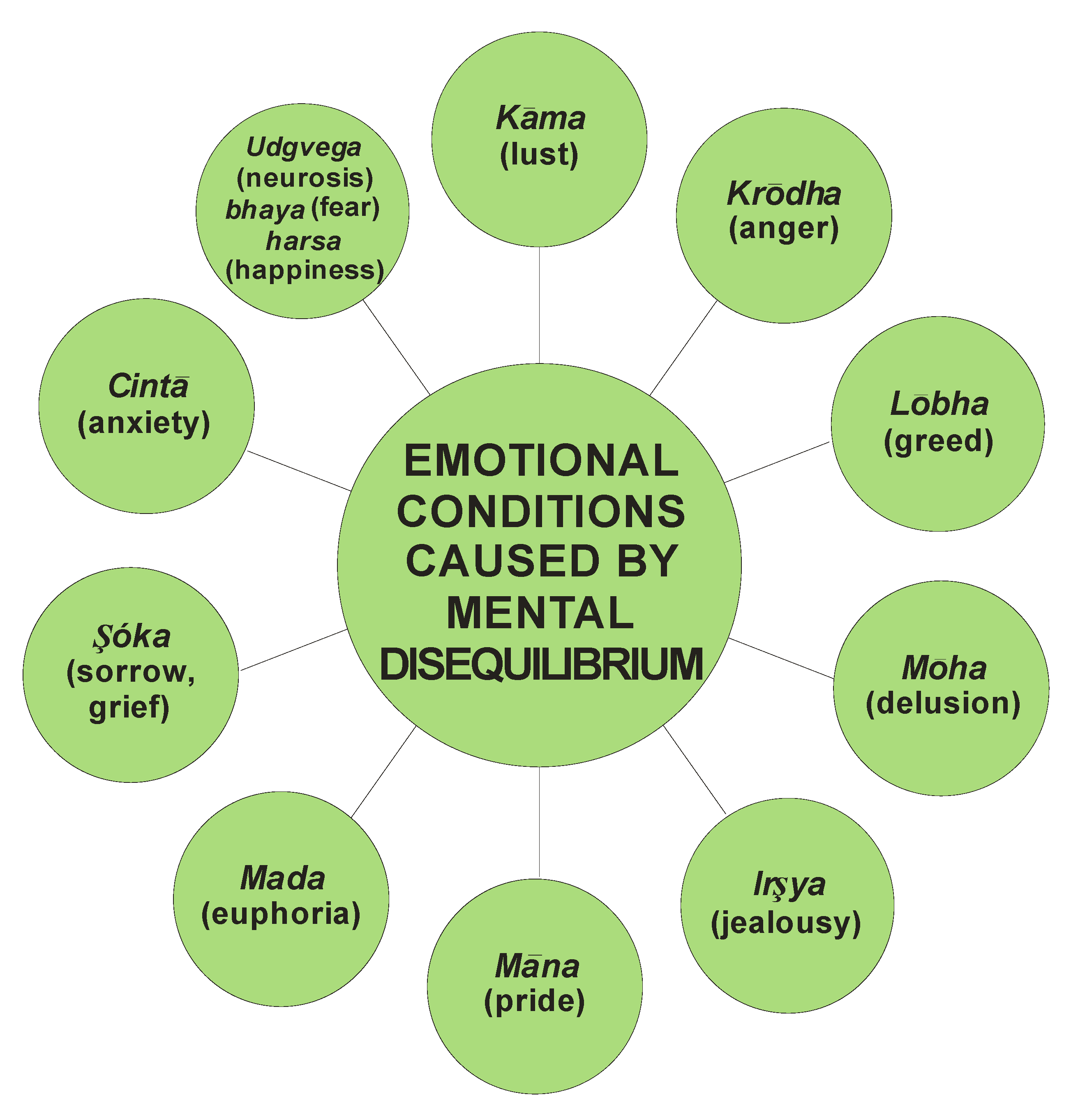
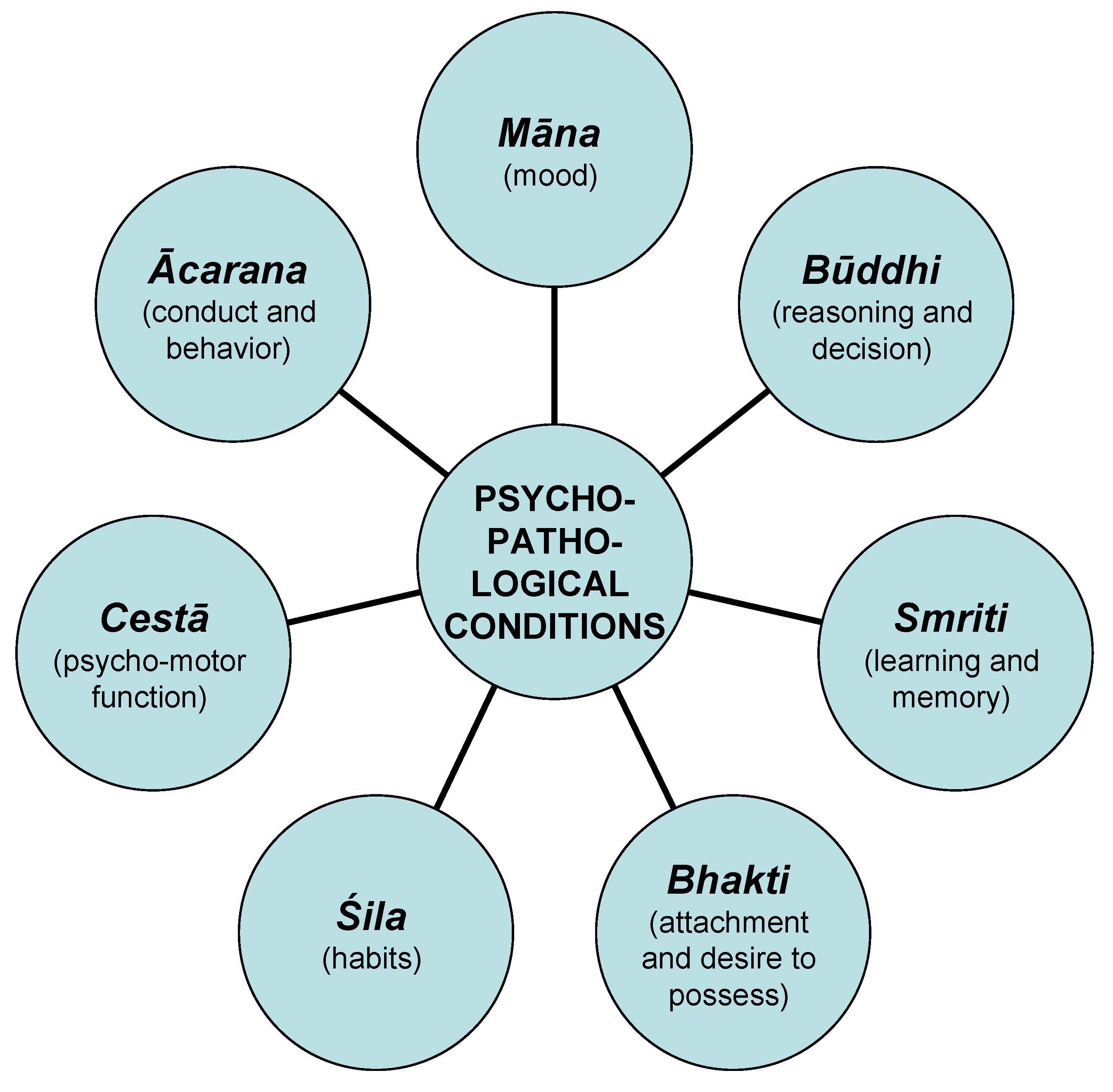
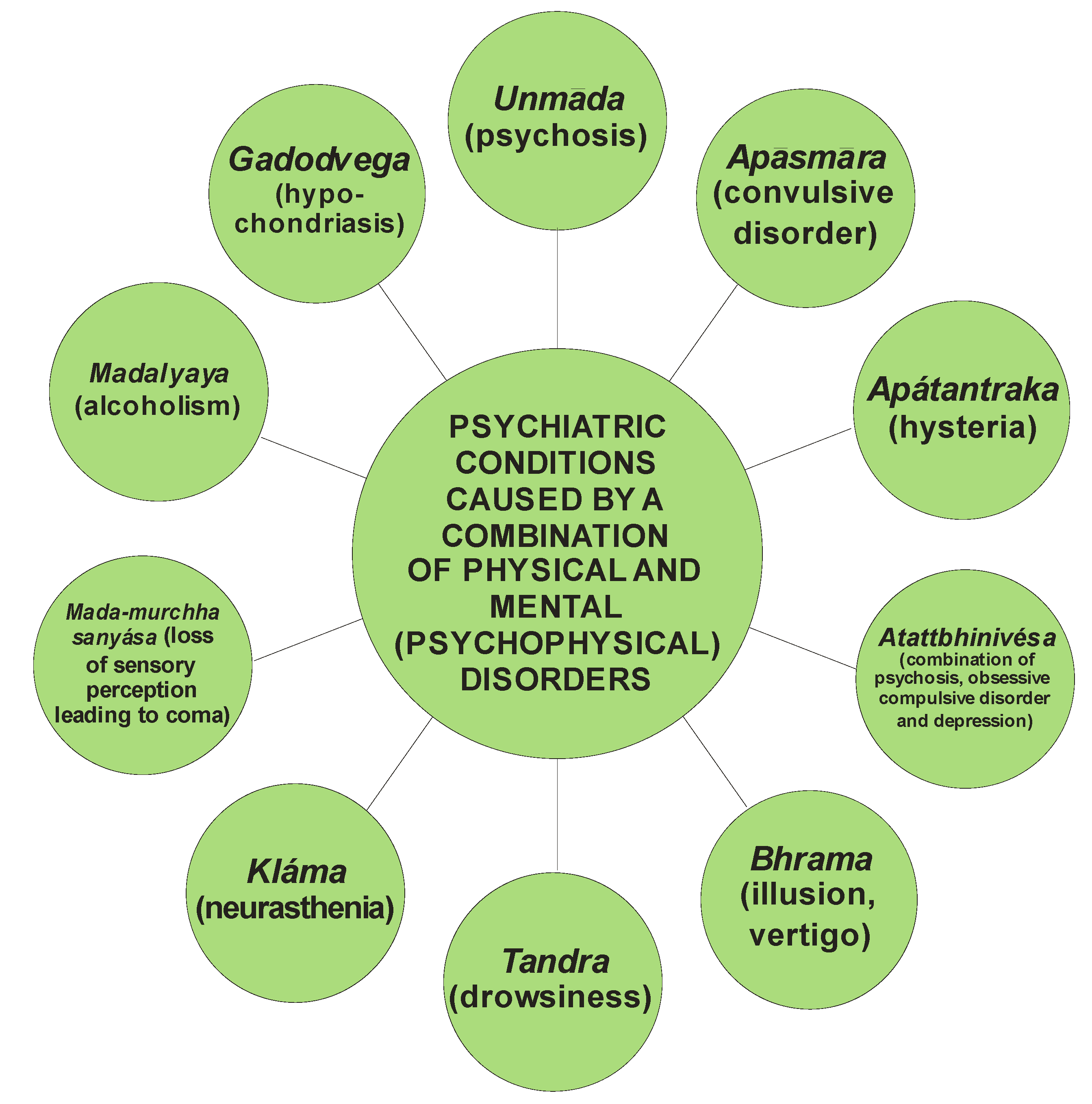
4. Rasayana and Treatment of Psychiatric Disorder
4.1. The Rasayana Concept
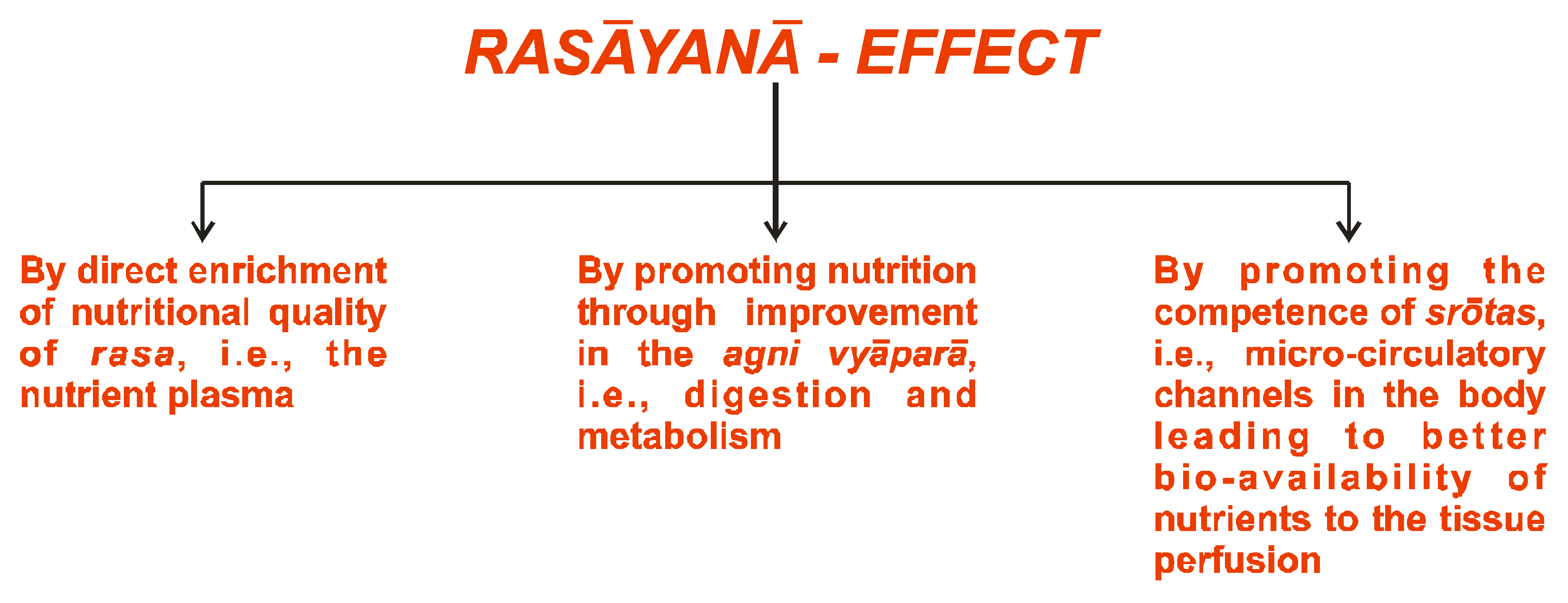
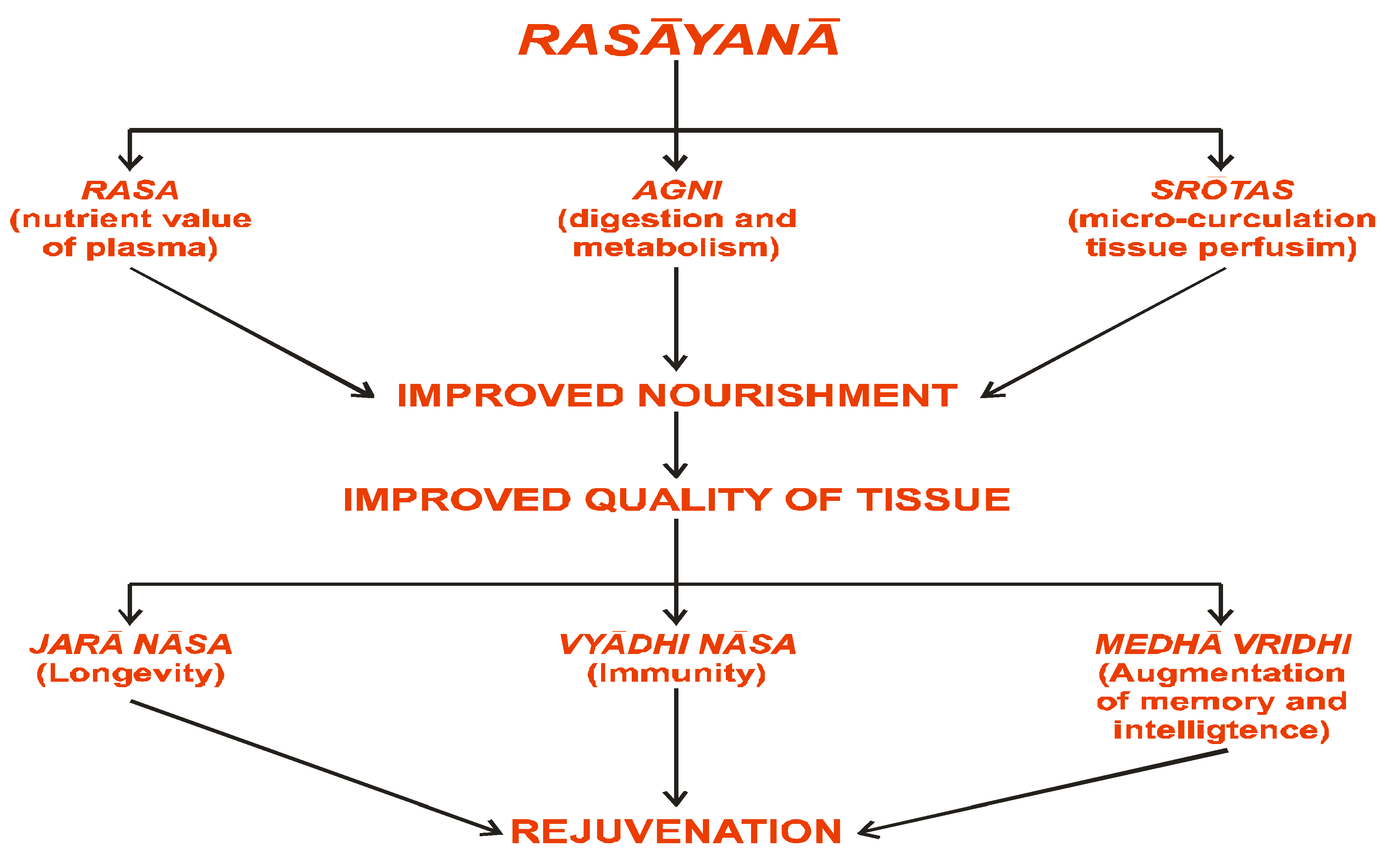
4.2. Ācara-Rasāyanā (Rejuvenating Code of Conduct)

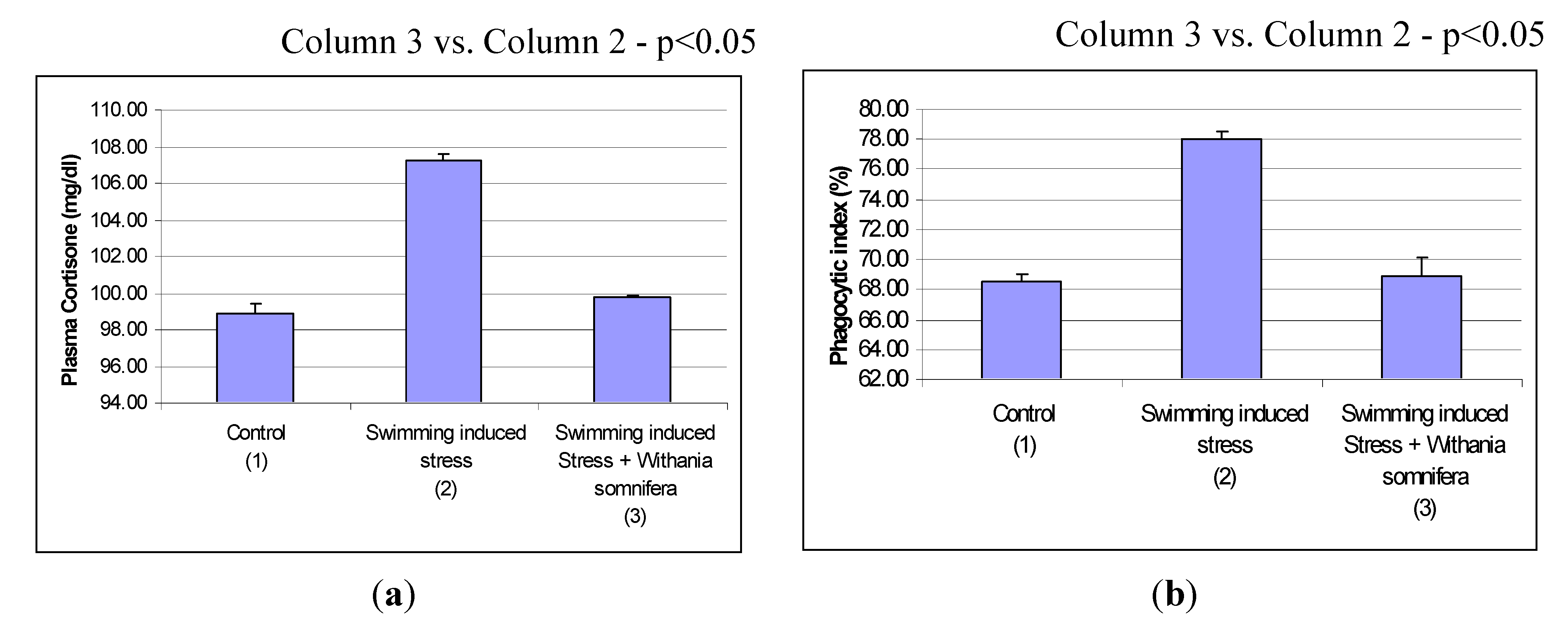
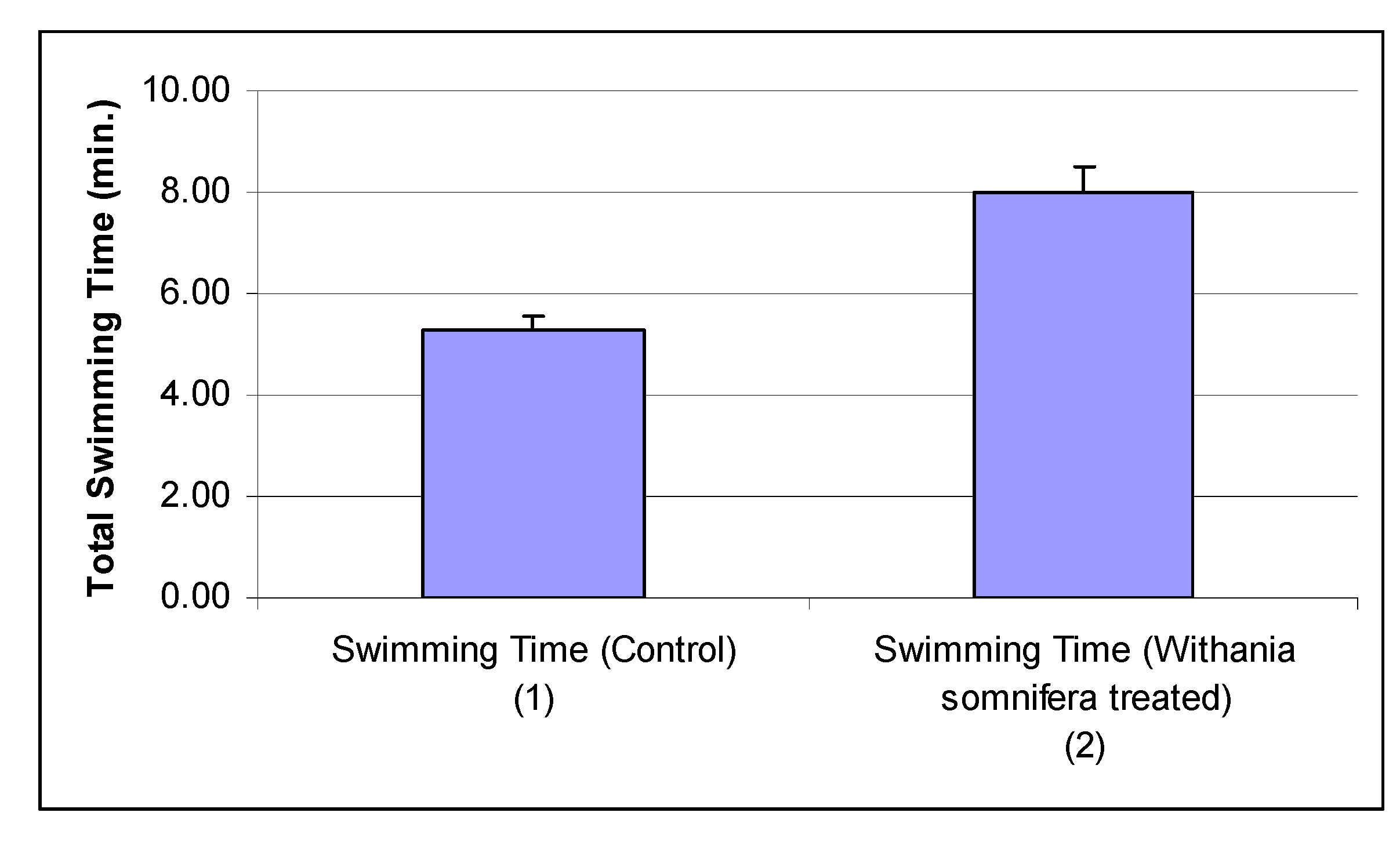
5. Medhya-Rasayana (Memory Enhancing and Rejuvenating) Plants
| Sl. No. | Botanical Nomenclature | Āyurvedic Nomenclature | Family |
|---|---|---|---|
| 1 | Acorus calamus | Vacha | Aracceae |
| 2 | Alternanthera sessilis | Matsyakshi | Amarnanthacceae |
| 3 | Argyreia speciosa | Vidhara | Convolvulaceae |
| 4 | Asparagus racemosus | Shatavari | Liliaceae |
| 5 | Bacopa monniera | Brahmi | Scrophulariaceae |
| 6 | Celastrus paniculatus | Jyotishmati | Celastraceae |
| 7 | Centella asiatica | Mandukparni | Umbelliferae |
| 8 | Clerodendrum infortunatum | Bhant | Verbanaceae |
| 9 | Clitoria ternatea | Aparajita | Leguminosae |
| 10 | Convolulus pluricaulis | Shankhpushpi | Convoluvalaceae |
| 11 | Curculigo orchiodes | Krishna musli | Amaryllidaceae |
| 12 | Dioscorea bulbifera | Varahi kand | Dioscoreacae |
| 13 | Enhydra fluctuans | Hilmochika | Compositae |
| 14 | Glycyrrhiza glabara | Yashtimadhu | Leguminosae |
| 15 | Jasminum sambac | Bela | Oleaceae |
| 16 | Mucuna pruriens | Kewanch | Leguminosae |
| 17 | Nardostachys jatamansi | Jatamansi | Valerianceae |
| 18 | Piper longum | Pippali | Piperaceae |
| 19 | Terminalia chebula | Haritaki | Combretaceae |
| 20 | Tinospora cordifolia | Amrita | Menispermaceae |
| 21 | Valeriana wallichii | Tagar | Valerianaceae |
| 22 | Vitex negundo | Nirgundi | Verbenaceae |
| 23 | Withania somnifera | Ashwagandha | Solanaceae |
Bacopa monniera

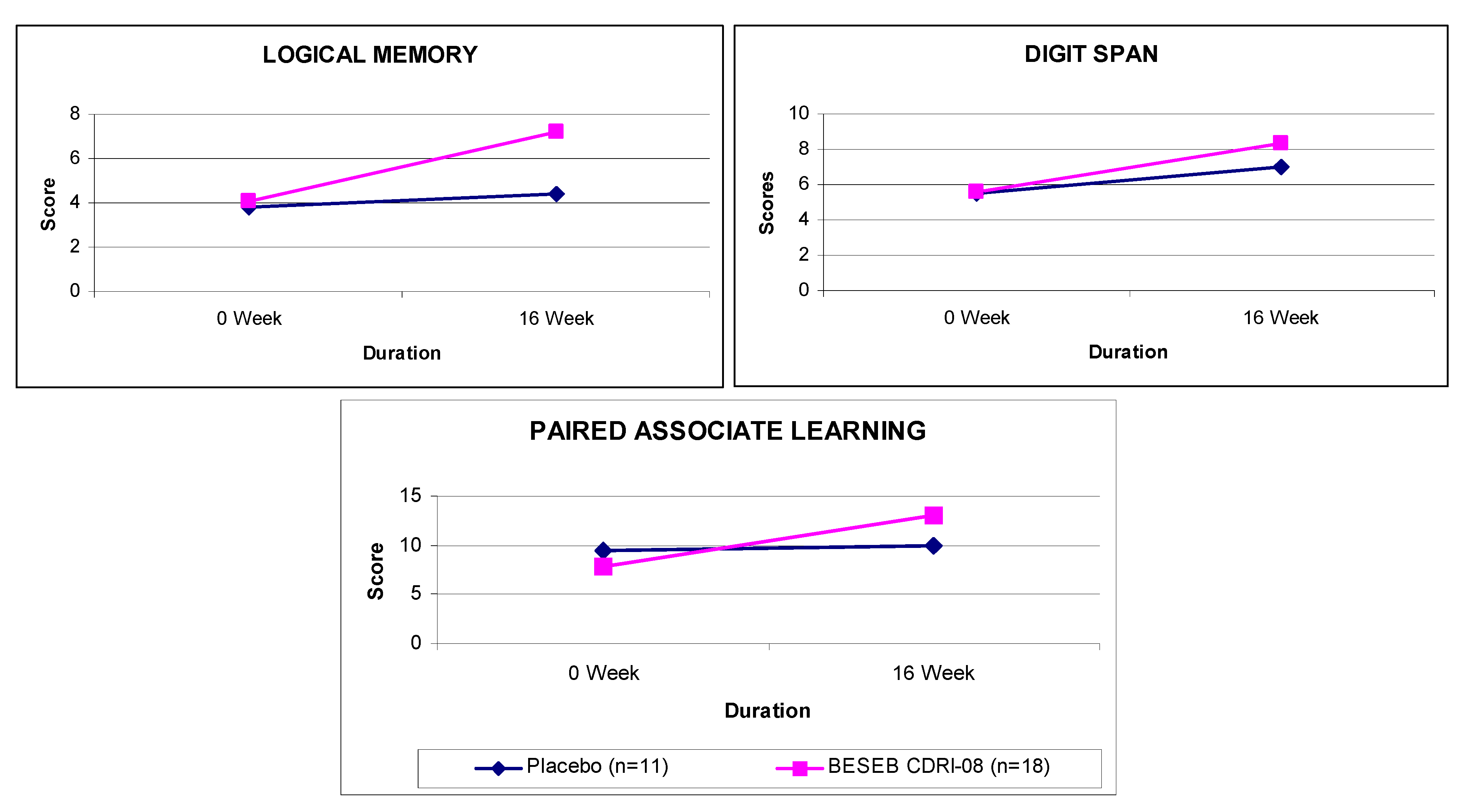
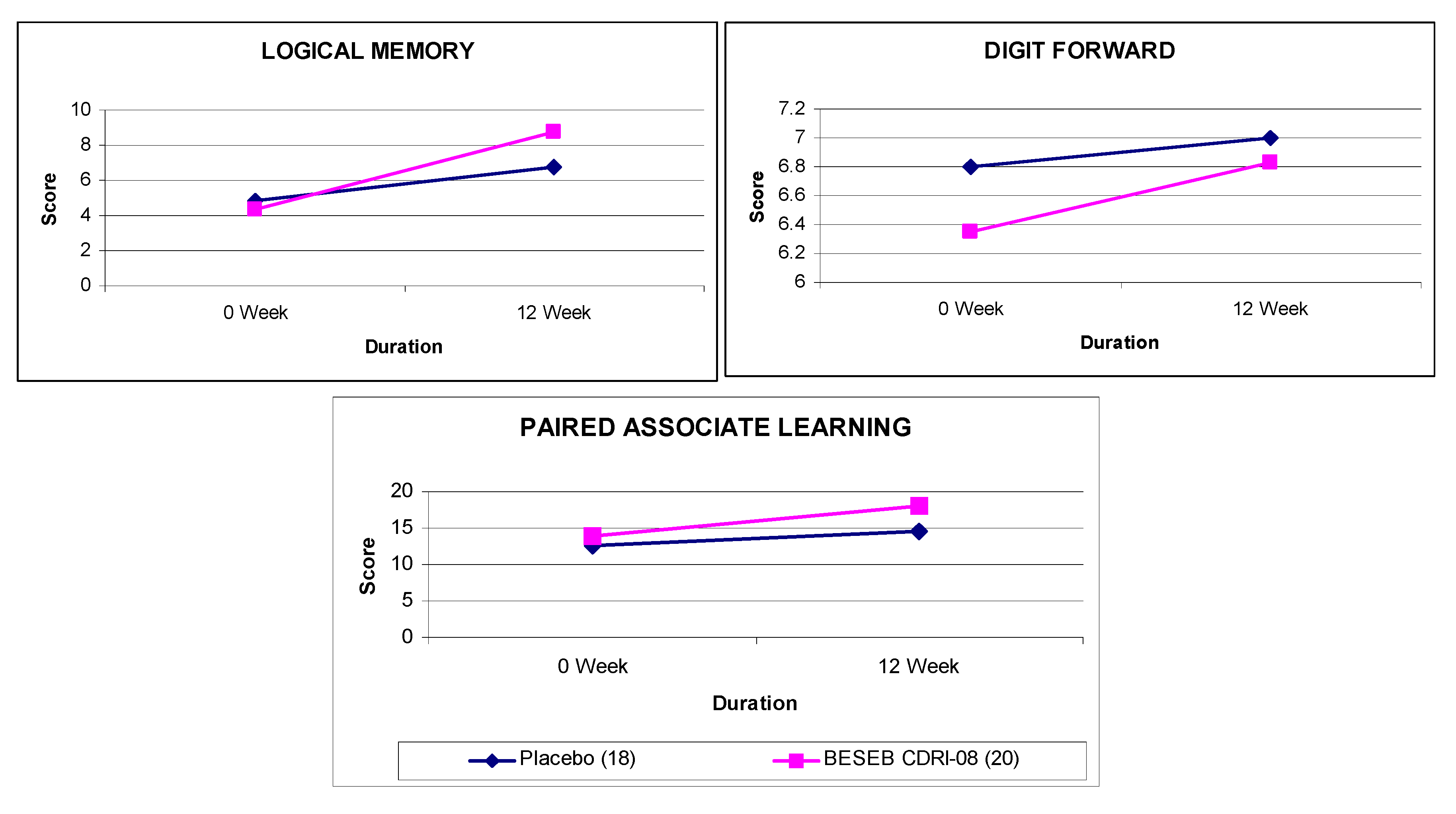
6. Conclusion
Acknowledgment
Conflict of Interest
References
- Sheth, S. Religion and Society in Brahma-Purana; Sterling: New Delhi, India, 1979; pp. 251–252. [Google Scholar]
- Schwartz, S. Psychoactive Herbs in Veterinary Behavioral Medicine; Blackwell Publishing: Oxford, UK, 2005; p. 70. [Google Scholar]
- Tewari, S.P. Royal Attendants in Ancient Indian Literature: Epigraphy & Art; Agam Kala Prakashan: Delhi, India, 1987; p. 117. [Google Scholar]
- Rao, R.S.K. Encyclopaedia of Indian Medicine: Historical Perspective; Popular Prakashan: Bombay, India, 2005; p. 106. [Google Scholar]
- Das, A.C. Rigvedic India; Motilal Banarasi Das: Mumbai, India, 1971; p. 85. [Google Scholar]
- Nigam, S. Economic Organisation in Ancient India: 200 BC–200 AD; Munshiram Manoharlal Publishers: New Delhi, India, 1975. [Google Scholar]
- Majumdar, R.C.; Pusalker, A.D.; Majumdar, A.K. The History and Culture of the Indian People; Bharatiya Vidya Bhawan: Bombay, India, 1977; p. 562. [Google Scholar]
- Auboyer, J.F. Daily Life in Ancient India from Approximately 200 BC to AD 200; Weidenfeld and Nicolson: London, UK, 1965. [Google Scholar]
- Auboyer, J.F. Daily Life in Ancient India; Phoenix Press: Los Angeles, CA, USA, 1965. [Google Scholar]
- Mitra, S. Hunting in the ancient age: Accounts of religious travelers. In History and Heritage of Indian Game Hunting; Rupa Publications: New Delhi, India, 2010; Volume Chapter 3, pp. 35–53. [Google Scholar]
- Rangrajan, L.N. Kautilya: The Arthasastra; Penguin Classics; Penguin Books India: New Delhi, India, 1992. [Google Scholar]
- Sharma, P.V. Çaraka-Samhitā: Agniveśa’s Treatise Refined and Annotated by Çaraka and Redacted by Dŕdhbala; Chaukhambha Orientalia: Varanasi, India, 2008. [Google Scholar]
- Singhal, G.D. Suśrūta-Samhitā; Chaukhamba Sanskrit Pratishhthan: Delhi, India, 2007. [Google Scholar]
- Singh, R.H. Banaras Hindu University: Varanasi, India, 2010; Personal communication.
- Nehru, J. First Five Year Plan: 1952–57; Planning Commission, Publications Division, Government of India: New Delhi, India, 1952. [Google Scholar]
- Dahanukar, S.; Thatte, U. Āyurvedā Revisited; Popular Prakashan: Bombay, India, 1989; p. 138. [Google Scholar]
- Singh, L. Studies on the anti-anxiety effect of the medya-rasāyanā drug, Brāhmi (Bacopa monniera). M.D. Thesis, Faculty of Medical Sciences, Banaras Hindu University, Varanasi, India, 1977. [Google Scholar]
- Shukla, C.P. Rasayana Cikitsa Revisited; Carak Memorial Oration, The Asiatic Society of Bengal: Kolkata, India, 1998. [Google Scholar]
- Singh, R.H.; Udupa, K.N. Rejuvenation Therapy. In Science and Philosophy of Indian Medicine; Baidyanath Ayurveda Bhawan: Nagpur, India, 1978. [Google Scholar]
- Singh, R.H.; Shukla, M.P. Elements of rasāyanā therapy in Sāranghdhara Samhitā. Nagarjuna 1976, 19, 1–5. [Google Scholar]
- Singh, R.H. Preventive and social medicine in Āyurveda. In History of Medicine in India; Sharma, P.V., Ed.; Indian National Science Academy: New Delhi, India, 1992; pp. 225–241. [Google Scholar]
- Singh, R.H. Rasāyanā and Vajikarana (Promotive Therapy). In History of Medicine in India; Sharma, P.V., Ed.; Indian National Science Academy: New Delhi, India, 1992; pp. 242–254. [Google Scholar]
- Sharma, P.V. Dravyaguna Vigyān Volume II: Vegetable Drugs; Chaukhamba Sanskrit Sansthan: Varanasi, India, 1986. [Google Scholar]
- Archana, R.; Nama Shivayam, A. Anti stress effect of Withania somnifera. J. Ethnopharmacol. 1999, 64, 91–93. [Google Scholar]
- Scartezzini, P.; Speroni, E. Review on some plants of Indian traditional medicine with antioxidant activity. J. Ethnopharmacol. 2000, 71, 23–43. [Google Scholar] [CrossRef]
- Govindrajan, R.; Vijayakumar, M.; Pushpangadan, P. Antioxidant approach to disease management and the role of ‘Rasayana’ herbs of Ayurveda. J. Ethnopharmacol. 2005, 99, 165–178. [Google Scholar] [CrossRef]
- Russo, A.; Borrelli, F. Bacopa monniera, a reputed nootropic plant: An overview. Phytomedicine 2005, 12, 305–317. [Google Scholar] [CrossRef]
- Diggavi, M.V. Role of Manas in Klaibya (male sexual dysfunctions) and its management with medhya rasāyana and uŗşya basti. M.D. Thesis, Department of Kāyaçikitsā, Institute of Post Graduate Teaching and Research in Āyurveda, Gujarat Āyurveda University, Jamnagar, India, 1998. [Google Scholar]
- Chatterjee, N.; Rastogi, R.P.; Dhar, M.L. Chemical Examination of Bacopa monniera Wettst: Part I—Isolation of Chemical Constituents. Ind. J. Chem. 1963, 1, 212–215. [Google Scholar]
- Chatterjee, N.; Rastogi, R.P.; Dhar, M.L. Chemical Examination of Bacopa monniera Wettst: Part II—The Constituents of Bacoside A. Ind. J. Chem. 1965, 3, 24–29. [Google Scholar]
- Basu, N.; Rastogi, R.P.; Dhar, M.L. Chemical Examination of Bacopa monniera Wettst: Part III—Bacoside B. Ind. J. Chem. 1967, 5, 84–86. [Google Scholar]
- Kulshreshtha, D.K.; Rastogi, R.P. Identification of ebelin lactone from Bacoside A and the nature of its genuine sapogenin. Phytochemistry 1973, 12, 2074–2076. [Google Scholar] [CrossRef]
- Ott, T.; Dosske, A.; Thiemann, W.; Matthies, H. Eine teilautomatishe Lernanlage für optische Diskriminierungs Versuche mit Ratten. Acta Biol. Med. Ger. 1977, 29, 1103–1108. [Google Scholar]
- Singh, H.K.; Ott, T.; Matthies, H. Effect of intrahippocampal injection of atropine on different phases of a learning experiment. Psychopharmacology (Berl.) 1975, 38, 247–258. [Google Scholar]
- Ott, T. Mechanismen der Gedächtuisbildung; Brain and Behavior Research Monograph Series Volume 7; VEB Gustav Fischer Verlag: Jena, Germany, 1977. [Google Scholar]
- Milner, B.; Teuber, H.L. In Analysis of Behavioral Change; Weiskrantz, L., Ed.; Harper & Row: New York, NY, USA, 1968; pp. 242–257. [Google Scholar]
- Singh, H.K.; Dhawan, B.N. Effect of Bacopa monniera Linn (Brahmi) on avoidance responses in rats. J. Ethnopharmacol. 1982, 5, 205–214. [Google Scholar] [CrossRef]
- Singh, H.K.; Dhawan, B.N. Pre-clinical neuro-psychopharmacological investigations on Bacosides: A nootropic memory enhancer. In Proceedings of Update Ayurveda 94, Mumbai, India, 24–26 February 1994.
- Singh, H.K.; Dhawan, B.N. Improvement of learning and memory by saponins of Bacopa monniera. Can. J. Physiol. Pharmacol. Abstr. 1994, 7251, 407. [Google Scholar]
- Singh, H.K.; Rastogi, R.P.; Srimal, R.C.; Dhawan, B.N. Effect of Bacosides A and B on avoidance responses in rats. Phytother. Res. 1988, 2, 70–75. [Google Scholar] [CrossRef]
- Singh, H.K.; Shanker, G.; Patnaik, G.K. Facilitation of memory by bacosides: Naturally occurring saponins. In Proceedings of the 3rd European Pharmacological Colloquium, Genova, Italy, 21–23 June 1996.
- Singh, H.K.; Shanker, G.; Patnaik, G.K. Neuro-pharmacological and anti-stress effects of bacosides: A natural memory enhancer. Ind. J. Pharmacol. 1996, 28, 47. [Google Scholar]
- Singh, H.K.; Srimal, R.C.; Dhawan, B.N. Neuro-psychopharmacological investigations on bacosides from Bacopa monniera. In Ethnopharmacologie: Methods, Objectives, Proceedings of Acta 1st Collogus European d’Ethnopharmacologie, Metz, France, 22–25 March 1990; pp. 319–322.
- Singh, H.K.; Srimal, R.C.; Srivastava, A.K.; Garg, N.K.; Dhawan, B.N. Neuro-psychopharmacological effects of bacosides A and B. In Proceedings of the Fourth International Conference of Neurobiology of Learning and Memory, Centre for Neurobiology of Learning and Memory, University of California, Irvine, CA, USA, 17–20 October 1990.
- Preethi, J.; Singh, H.K.; Charles, P.D.; Emmanuvel Rajan, K. Participation of microRNA 124-CREB pathway: A parallel memory enhancing mechanism of standardised extract of Bacopa monniera (BESEB CDRI-08). Neurochem. Res. 2012, 37, 2167–2177. [Google Scholar] [CrossRef]
- Decker, M.W.; McGaugh, J.L. The role of interaction between the cholinergic system and other neuromodulatory systems in learning and memory. Synapse 1991, 7, 151–168. [Google Scholar] [CrossRef]
- Matsukawa, M.; Ogawa, M.; Nakadate, K.; Maeshima, T.; Ichitani, Y.; Kawai, N.; Okado, N. Serotonin and acetylccholine are crucial to maintain hippocampal synapses and memory acquisition in rats. Neurosci. Lett. 1997, 230, 13–16. [Google Scholar] [CrossRef]
- Stancampiano, R.; Cocco, S.; Cugusi, C.; Sarais, L.; Fadda, F. Serotonin and acetylcholine release response in the rat hippocampus during a spatial memory task. Neuroscience 1999, 89, 1135–1143. [Google Scholar] [CrossRef]
- Nail-Boucherie, K.; Dourmap, N.; Jaffard, R.; Costentin, J. Contextual fear conditioning is associated with an increase of acetylcholine release in the hippocampus of rat. Brain Res. Cogn. Brain Res. 2000, 9, 193–197. [Google Scholar] [CrossRef]
- Srivastava, S. Data on Sub-Acute Toxicity Study on Rodents and Non-Human Primates of CDRI-08; Report No. 1/1996; The internal report of the Central Drug Research Institute: Lucknow, India, 1996. [Google Scholar]
- Srivastava, S. Data on Teratogenicity Study of Standardised Extract of Bacopa monniera CDRI-08 by Oral Route; Report No. 2/1989; The internal report of the Central Drug Research Institute: Lucknow, India, 1996. [Google Scholar]
- Giri, A.K.; Khan, K.A. Genetic Toxicity Studies of Standardised Extract of Bacopa monniera Extract CDRI-08; Report No. 3/1990; The internal report of the Central Drug Research Institute: Lucknow, India, 1996. [Google Scholar]
- Negi, K.S.; Singh, Y.D.; Kushwaha, K.P.; Rastogi, C.K.; Rathi, A.K.; Srivastava, J.S.; Asthana, O.P.; Gupta, R.C. Clinical evaluation of memory enhancing properties of standardized extract of Bacopa monniera in children with Attention Deficit Hyperactivity Disorder. Indian J. Psychiatry 2000, 42, 25. [Google Scholar]
- Sharma, D. Double blind placebo controlled trial of standardized Bacopa monniera extract in Age Associated Memory Impairment. M.D. Thesis, Baba Raghav Das Mediccal College, Deen Dayal Upadhaya University, Gorakhpur, India, 2000. [Google Scholar]
- Singh, S. Clinical evaluation of standardized Bacopa monniera extract in elderly subjects with age associated memory impairment. M.D. Thesis, King George’s Medical College, University of Lucknow, Lucknow, India, 2001. [Google Scholar]
- Raghav, S.; Singh, H.; Dalal, P.K.; Srivastava, J.S.; Asthana, O.P. Randomised controlled trial of standardized Bacopa monniera extract in age-associated memory impairment. Indian J. Psychiatry 2006, 48, 238–242. [Google Scholar] [CrossRef]
- Patwardhan, B. Botanical immuno drugs: Scope and opportunities. Drug Discov. Today 2005, 10, 495–502. [Google Scholar] [CrossRef]
- Patwardhan, B. Ethnopharmacology and drug discovery. J. Ethnopharmacol. 2005, 100, 50–52. [Google Scholar]
- Guo, R.; Pittler, M.H.; Ernst, H. Herbal medicines for the treatment of allergic rhinitis: A systematic review. Ann. Allergy Asthma Immunol. 2007, 99, 483–495. [Google Scholar] [CrossRef]
- Balachandran, P.; Govindarajan, R. Cancer—An ayurvedic perspective. Pharmacol. Res. 2005, 51, 19–30. [Google Scholar] [CrossRef]
- Anekonda, T.S.; Reddy, P.H. Can herbs provide a new generation of drugs for treating Alzheimer’s disease? Brain Res. Brain Res. Rev. 2005, 50, 361–376. [Google Scholar] [CrossRef]
© 2013 by the authors; licensee MDPI, Basel, Switzerland. This article is an open access article distributed under the terms and conditions of the Creative Commons Attribution license (http://creativecommons.org/licenses/by/3.0/).
Share and Cite
Singh, H.K. Brain Enhancing Ingredients from Āyurvedic Medicine: Quintessential Example of Bacopa monniera, a Narrative Review. Nutrients 2013, 5, 478-497. https://doi.org/10.3390/nu5020478
Singh HK. Brain Enhancing Ingredients from Āyurvedic Medicine: Quintessential Example of Bacopa monniera, a Narrative Review. Nutrients. 2013; 5(2):478-497. https://doi.org/10.3390/nu5020478
Chicago/Turabian StyleSingh, Hemant K. 2013. "Brain Enhancing Ingredients from Āyurvedic Medicine: Quintessential Example of Bacopa monniera, a Narrative Review" Nutrients 5, no. 2: 478-497. https://doi.org/10.3390/nu5020478




